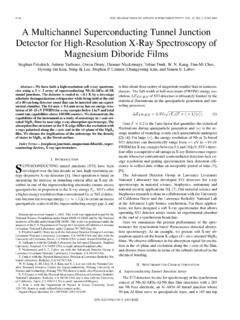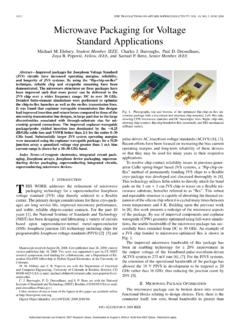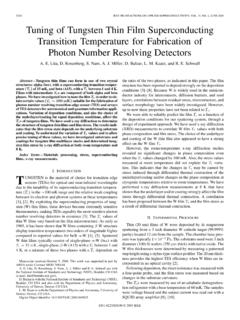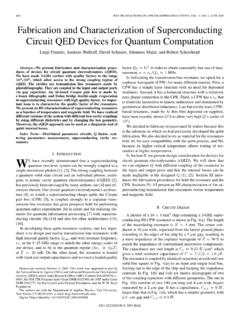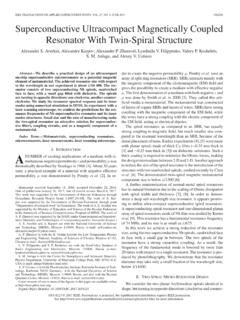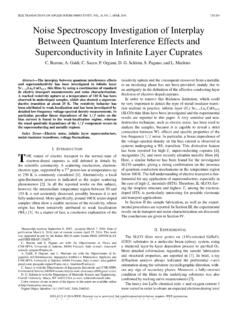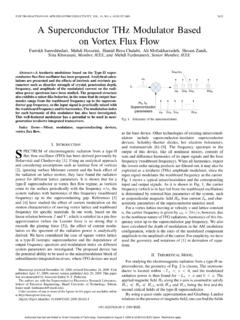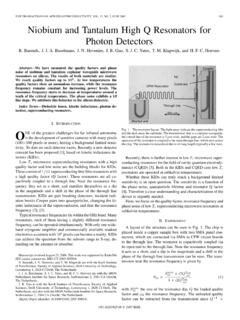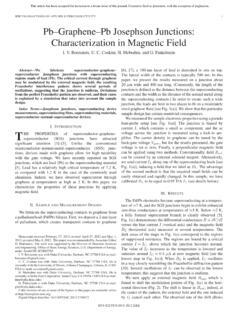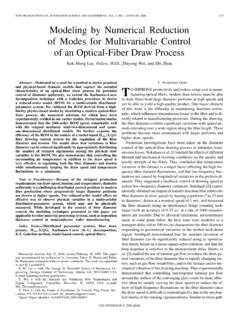Transcription of 1612 IEEE TRANSACTIONS ON BIOMEDICAL ENGINEERING, …
1 1612 ieee TRANSACTIONS ON BIOMEDICAL engineering , VOL. 58, NO. 6, JUNE 2011 bayesian regularization applied to UltrasoundStrain ImagingMatthew McCormick , Student Member, ieee , Nicholas Rubert, Student Member, ieee ,and Tomy Varghese, Senior Member, IEEEA bstract Noise artifacts due to signal decorrelation and rever-beration are a considerable problem in ultrasound strain imag-ing. For block-matching methods, information from neighboringmatching blocks has been utilized to regularize the estimated dis-placements. We apply a recursive bayesian regularization algo-rithm developed by Haytonet al.[Artif. Intell., vol. 114, pp. 125 156, 1999] to phase-sensitive ultrasound RF signals to improvedisplacement estimation. The parameter of regularization is re-formulated, and its meaning examined in the context of strainimaging.
2 Tissue-mimicking experimental phantoms and RF dataincorporating finite-element models for the tissue deformation andfrequency-domain ultrasound simulations are used to compute theoptimal parameter with respect to nominal strain and algorithmiciterations. The optimal strain regularization parameter was foundto be twice the nominal strain and did not vary significantly withalgorithmic iterations. The technique demonstrates superior per-formance over median filtering in noise reduction at strains 5% andhigher for all quantitative experiments performed. For example,the strain SNR was 11 dB higher than that obtained using a medianfilter at 7% strain. It has to be noted that for applied deformationslower than 1%, since signal decorrelation errors are minimal, usingthis approach may degrade the displacement Terms Bayes procedures, BIOMEDICAL acoustic imaging, BIOMEDICAL imaging, displacement measurement, image motionanalysis, strain INTRODUCTIONULTRASOUND strain imaging algorithms can generally bedivided into two independent stages, namely: estimationof the local displacements from a predeformation to a postde-formation state, and computation of local strain from these esti-mated displacements.
3 The first stage can be considered to be aninstance of the general deformable image registration problem[1], [2]. Approaches to the registration problem include dif-ferential methods of estimating optical flow [3], [4], optimiza-Manuscript received August 6, 2010; revised October 20, 2010 andNovember 23, 2010; accepted December 17, 2010. Date of publicationJanuary 17, 2011; date of current version May 18, 2011. This work was supportedin part by the National Institute of Health (NIH) under Grant R21 EB010098-02, Grant R01 NS064034-01A2, and Grant R01CA112192-S103. The work ofM. McCormick was supported by the National Institute of Diabetes and Diges-tive and Kidney Diseases under Grant T90DK070079 and Grant indicates corresponding author. M. McCormick is with the University of Wisconsin Madison, Madison, WI53706 USA (e-mail: Rubert and T.)
4 Varghese are with the University of Wisconsin Madison,Madison, WI 53706 USA (e-mail: versions of one or more of the figures in this paper are available onlineat Object Identifier of a global deformation model s parameters [5] [7], andblock-matching methods [8] [12]. While global deformationalmodels are popular for registration in other imaging modali-ties, the pixel dimensions and high frequency speckle contentof ultrasonic signals lead to a significant computational burden,along with a difficult to navigate optimization parameter spacewith abundant local extrema [7], [13]. Block-matching methodsare not as computationally expensive, but only local informa-tion determines displacement estimated from a matching makes it difficult to enforce diffeomorphic deformation,and it puts block-matching techniques at a disadvantage com-pared to methods that simultaneously incorporate informationfrom the entire image space.)
5 In order to improve the quality ofblock-matching-based motion tracking, regularization strategiesare employed that fuse information from neighboring matchingblocks [13] [16].In ultrasonic displacement estimation, signal decorrelationduring block-matching introduces peak-hopping errors and de-grades the quality of the resulting strain or modulus image [17],[18]. Signal decorrelation may be due to large axial deforma-tions distorting the signal, elevational motion of the probe, orunwanted physiological motion [19], [20].There are primarily two strategies employed in the peer-reviewed literature to correct for displacement estimation er-rors. One strategy aims to reduce peak hopping by restrictingthe search area of a matching block. Smaller search areas arefeasible when the center of the search region is initialized appro-priately, where the search may propagate away from a region ofknown displacement such as the face of the transducer [8], [21]or lines or points with high confidence [22], [23].
6 Alternatively,a coarse-to-fine scheme may be employed where displacementsfrom a large matching block or low-pass filtered and subsam-pled matching block initializes the center of the search regionat progressively smaller matching block sizes to achieve a highresolution strain image [8], [13], [24] [27].The other commonly employed strategy used to reducenoise in ultrasound displacement estimation is to incorpo-rate displacements from neighboring blocks into the displace-ment estimation equation. Filtering approaches, such as amedian [28] or Kalman filter [16], remove noise but comeat the cost of reduced strain dynamic range and spatialresolution. Alternatively, motion within tissue may be as-sumed to be continuous, and displacements may be esti-mated by minimizing a cost function incorporating a terminvolving a similarity metric and a term involving displace-ment continuity between adjacent matching blocks.
7 This costfunction can then be minimized with iterative techniques0018-9294/$ 2011 IEEEMCCORMICK et al.: bayesian regularization applied TO ultrasound STRAIN IMAGING1613[15], [16], [29] or application of the Viterbi algorithm [14] or ina multiscale context [13].In this paper, we examine a regularization approach that at-tempts to optimize the displacement using both the block simi-larity metric and the motion of neighboring blocks. However, un-like the aforementioned algorithms, we do not explicitly formu-late the problem as the minimization of a cost function. Instead,we follow the approach proposed by Haytonet al.[30], wherethe similarity metric is viewed in a probabilistic bayesian regularization is applied based on the simi-larity metric observed in neighboring blocks. Haytonet al.[30]originally applied this method for deformable image registrationof magnetic resonance images obtained during breast also applied this method to the registration of3-D B-mode ultrasound subvolumes [31].
8 In the remaining sec-tions, we first review the theoretical aspects of the algorithmand derive extensions that are relevant to strain imaging. Next,we describe the evaluation of the performance of this algorithmon tissue-mimicking (TM) phantoms and finite-element-basedsimulation experiments. Example images from a liver ablation,carotid atheroma, and breast carcinoma are examined. We alsoevaluate the characteristics of the main algorithmic parameter,the strain regularization sigma (SRS). This parameter imposesa Gaussian distribution on the estimated strain. Finally, we con-clude with a discussion of the algorithm s application in poten-tial improvement of clinical strain imaging MATERIALS ANDMETHODSA. AlgorithmIn block-matching methods, a small matching block fromthe predeformation image is compared to the postdeformationimage using a similarity metric [11], [32].
9 We assume the com-parison is made on a regular grid of points by translating thematching block within a specified search region. The grid ofsimilarity metric values located at the matching block s centerdefine a similarity metric image associated with the matchingblock utilized for displacement estimation. Examples of similar-ity metrics include sum of absolute difference, sum-of-squareddifferences, normalized cross correlation, phase correlation, ormutual information [1], [2].We can treat the similarity metric image as a probability den-sity image for the displacement of the matching block by ap-plying a few basic transformations. First, the similarity must beinverted, if necessary, such that the maximum value correspondsthe region with the greatest similarity. Next, the metric must beshifted by the negative of the metric s theoretical minimum, sothe smallest resulting value is zero.
10 In the case of normalizedcross correlation, is added to the similarity metric since itsbounds are[ 1,1]. For most other similarity metrics, this isa null operation. Finally, the similarity metric values are nor-malized by their sum such that integral of all values is similarity metric image can now be treated as a probabilitydensity image for displacement estimation that has a discreteform with sample spacing equal to the input images samplespacing. A value of zero in the probability density image occursat the metric s theoretical minimum with the sum of discreteprobabilities being probability density images obtained are prior probabilitydensity estimates,Pr(ux), in a bayesian frameworkPr(ux|uNx)=Pr(uNx|ux)Pr(ux)Pr(u Nx)whereuxis the displacement of the matching block at locationxanduNxis the displacement at neighboring matching this 2-D case, we use the four neighbors, two axial and twolateral.
